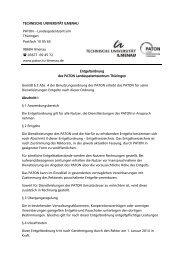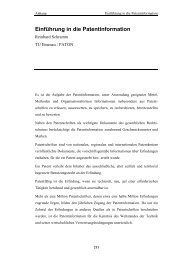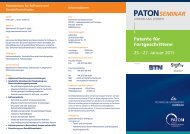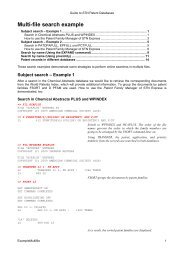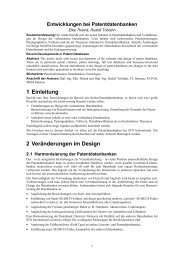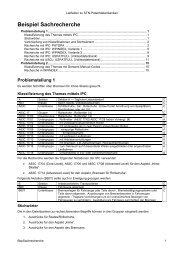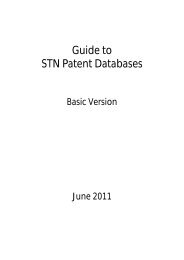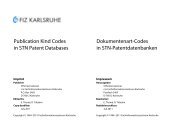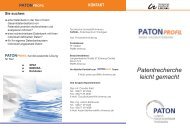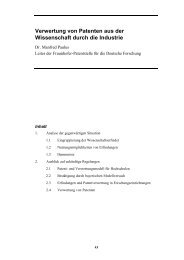Guide to STN Patent Databases – Basic Version - Paton - TU Ilmenau
Guide to STN Patent Databases – Basic Version - Paton - TU Ilmenau
Guide to STN Patent Databases – Basic Version - Paton - TU Ilmenau
You also want an ePaper? Increase the reach of your titles
YUMPU automatically turns print PDFs into web optimized ePapers that Google loves.
L2 71 BRANDENBURG K/IN<br />
=> S BRANDENBURG K?/IN<br />
L3 76 BRANDENBURG K?/IN<br />
The parts of a name can be linked with (S) proximity:<br />
=> S (BRANDENBURG (S) K)/IN<br />
324 BRANDENBURG/IN<br />
2632995 K/IN<br />
L10 81 (BRANDENBURG (S) K)/IN<br />
Types of search<br />
The names are normalized in the index, i.e. special characters have been removed.<br />
The name of the Inven<strong>to</strong>r indicated on the first page of the <strong>Basic</strong> <strong>Patent</strong> is available in the Inven<strong>to</strong>r field (since 1978).<br />
In older documents surnames with more than 10 letters were abbreviated (e.g. Tautzenberger Tautzenber); more<br />
recent documents (from 1985) additionally contain the full name. Both forms should be searched. From 1980, up <strong>to</strong><br />
8 Inven<strong>to</strong>r names have been entered, before that time 3 at the most. Similarly, only 3 names are entered for Soviet<br />
(SU) patents. Japanese inven<strong>to</strong>rs (from A and B publications) are entered from Derwent Week 200537. Inven<strong>to</strong>rs<br />
from small countries are sometimes missing.<br />
In older documents (up <strong>to</strong> 1985) names with umlauts are entered only with the corresponding basic vowel (e.g.<br />
Müller Muller); more recent documents additionally contain the name with converted umlaut (Mueller). Both<br />
forms should, as a rule, be searched. Multi-part surnames can be searched in various ways, e.g.: von Danwitz is<br />
searchable as VONDANWITZ or as VON DANWITZ.<br />
In DPCI and DGENE there is only a phrase index for the inven<strong>to</strong>r names (/IN field), i.e. the family name must be used<br />
<strong>to</strong>gether with the initial(s) or with truncation, if necessary.<br />
20.5.2 <strong>Patent</strong> assignee<br />
A mixed index with system interpretation is used for <strong>Patent</strong> Assignees; individual words from the name therefore<br />
appear in one list along with the name ranked as a phrase. Usually a search by single words is assumed. (S)<br />
proximity is used au<strong>to</strong>matically:<br />
=> S PROCTER & GAMBLE/PA<br />
11204 PROCTER/PA<br />
11273 GAMBLE/PA<br />
L2 11170 PROCTER & GAMBLE/PA<br />
((PROCTER(S)GAMBLE)/PA)<br />
If the name is <strong>to</strong> be searched as a phrase it must be entered with quotation marks:<br />
or<br />
=> S "PROCTER & GAMBLE CO"/PA<br />
L3 11059 "PROCTER & GAMBLE CO"/PA<br />
=> S "PROCTER & GAMBLE"?/PA<br />
L4 11169 "PROCTER & GAMBLE"?/PA<br />
The truncation character ? must immediately precede the slash and not be included in the quotation marks.<br />
If several entries are contained in the name field every name will be treated as one sentence ((S) proximity). Names<br />
in a record are always in alphabetical order (may be different from the <strong>Patent</strong> Gazette).<br />
The complete name (up <strong>to</strong> 40 letters) is entered for each <strong>Patent</strong> Assignee. Until Derwent week 9216, a maximum of<br />
24 letters were used.<br />
Since Derwent week 9216, all <strong>Patent</strong> Assignees (including those of the Equivalents) are added <strong>to</strong> the PA field. Prior<br />
<strong>to</strong> this, the number of the patent assignees was limited <strong>to</strong> 4. Differing patent assignees of the Equivalents have been<br />
added since 1976 (Derwent-Week 7648). The names of <strong>Patent</strong> Assignees (/PA) are searchable since 1970 (year of<br />
introduction in<strong>to</strong> the database).<br />
In addition <strong>to</strong> the name of the <strong>Patent</strong> Assignee, a code is entered in<strong>to</strong> the database by the database producer (in<strong>to</strong><br />
the PACO field). (For the years 1963 <strong>to</strong> 1969, only this code is available.) The code consists of four (three up <strong>to</strong> 1970)<br />
letters and, where appropriate, a further symbol of identification:-<br />
123



